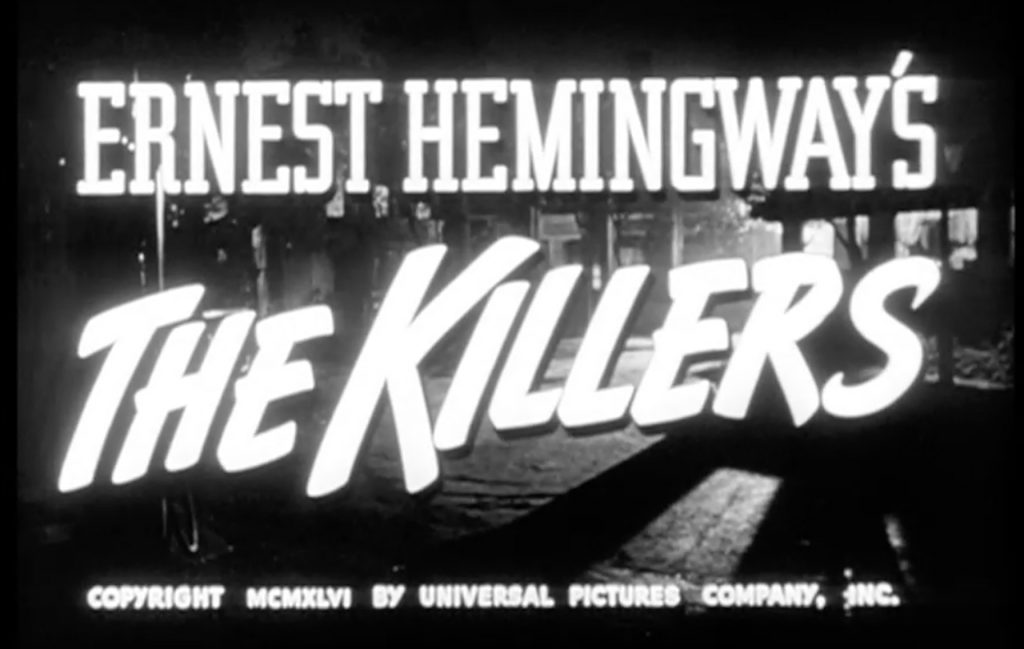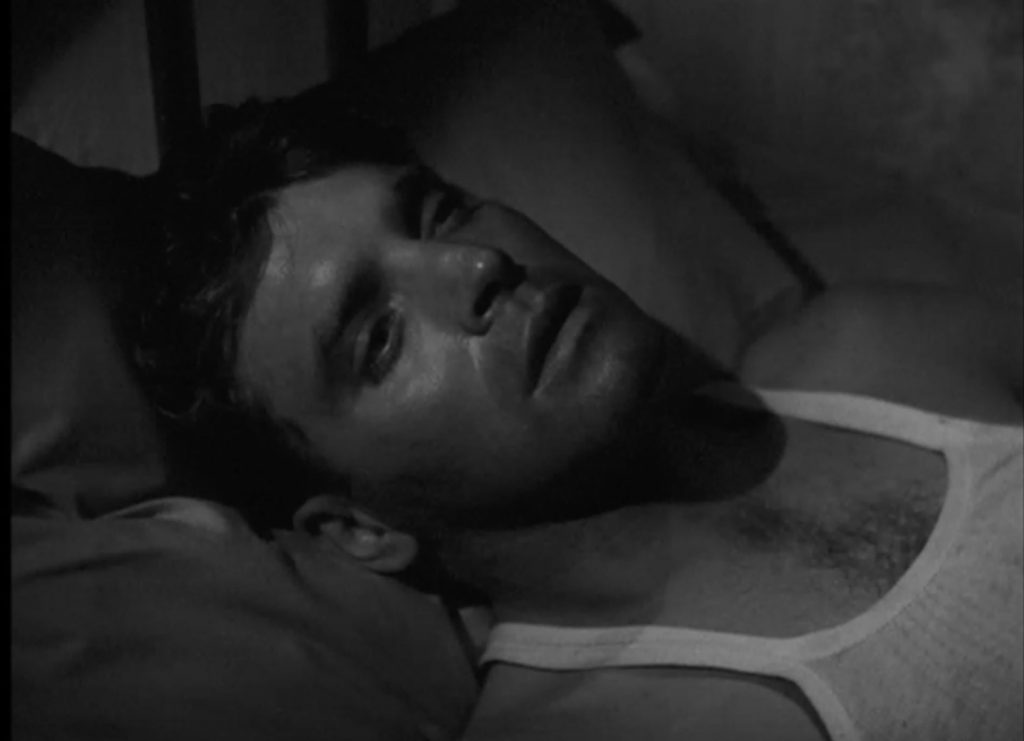Adaptation is a contentious term when it comes to translating a beloved piece of literature to the silver screen. Upon an announcement that a certain source material is being adapted into the film medium, devout fans of that particular material begin conjuring their interpretation of that story; how it will play on screen, what elements will remain, what actors will play their favorite characters, etc. Rarely does a movie adaptation marry itself to every minute detail of its former medium. Adaptation is meant to instill a viewer with an enlightened sense of what made the original story so encapsulating, and that sometimes means cutting “meat” from the original story in order to make its cinematic counterpart flow more coherently. In the movie adaptation of Ernest Hemingway’s The Killers (1946, dir. Robert Siodmak), much of the original story remains intact, with only slight trimming or inconsequential altering to the dialogue. But rather than mirroring and bloating Hemingway’s original narrative and placing the entire film within the confines of a lowly diner, director Robert Siodmak and crew use the original story as a gateway to a film noir narrative of deceit and resignation.

Ernest Hemingway’s name in the title denotes the level of authorship he possessed during production
Both stories begin the same: two men, wearing similarly dark outfits and derby caps, enter a diner as the sun begins to settle. They study their surroundings, as though they are looking for something… or rather, someone. They sit and order from the menus in front of them. Comically, everything they attempt to order is part of the “dinner menu,” which won’t be served until six o’clock (it is five, but the clock is 20 minutes fast—much to their chagrin). “Everything we want’s the dinner, eh? That’s the way you work it” (Hemingway 1), says one of the men, later identified as Max.

Men in black: the colors of the antagonists’ outfits represent their level of power
Immediately, based on this small interaction, the readers and viewers of both respective works are notified that these men are not to be trifled with. They’re here on business, they clearly have a thorn to pick with someone, and most of all, they’re on a wire; any inconvenience will result in misery for those around them. In both works, it is undeniable that these men are up to no good. In Hemingway’s short story, the reader picks up on this based on the dialogue alone. In Siodmak’s film, it is based not only on the dialogue, but also on how the Max and Al are visually represented. Clad in black and wearing the same displeased looks on their faces, while also being clumped together to make the black-and-white film even darker, these two men are the dominant force in the diner—a specter in this otherwise bright, shiny, and safe location. While this could’ve easily been written into the original story—which is no way a slight against Hemingway’s skills as a writer—the visual interpretation is more visceral and intimidating.
As expected, Max and his partner Al usher two of the diner’s occupants—customer Nick Adams and cook Sam—into the back against their will while Max remains with server George to inquire about the location of one Ole Anderson. Here is where, arguably, the biggest deviation occurs between the film and the short story. Whereas in the original story Max is forthcoming about his intentions—“We’re going to kill a Swede. Do you know a big swede named Ole Anderson?” (Hemingway 2)—his cinematic counterpart adds an element of mystery and extends the plot in what initially appears to be an insignificant way, but later turns out to be a whole a new element not found in Hemingway’s short story.

“We’re going to kill a Swede”
“I’ll tell what’s gonna happen,” says Max. “We’re gonna kill a Swede. Do you know a big Swede that works over at that filling station?” he asks George, gesturing to the unseen gas station across the street.
“You mean Pete Lund?” an apprehensive George asks.
Smoking a cigarette and casually aloof in his demeanor, Max replies, “If that’s what he’s calling himself…”
This difference in approach suggests to the viewers of the film that Ole is more guarded about his identity than in the short story. This version of Ole is hiding from a past that he wishes would stop following him. In the short story, none of this present; Ole is well-known and seems to be content with that fact.
From here, the plot of the film carries out the rest of the short story’s narrative largely unchanged: Max informs George that the nature of his and Al’s ire is strictly business. Al ties up Nick and Sam while George informs Max that Ole/Pete isn’t coming. (It should be noted, however, that in the short story George provides no reason why Ole isn’t coming, whereas in the film he says it’s because “Pete” always comes before six o’clock and never after.) Max and Al eventually accept George’s revelation and leave the diner. George then unties Nick and Sam, only for Nick to run for Ole/Pete and warn him that two men are after him for unspecified reasons. In both cases, with almost-startling literary accuracy, Ole/Pete is resigned to his fate. He lies in bed, still in his day clothes, and stares absent-mindedly at the wall, never meeting Nick’s gaze.
“I’m through with all that running around,” Ole/Pete says after Nick asks if he’s going to run, or at least go to the police. “Thanks for coming.”

Ole resigns himself to his fate and awaits his inevitable end
Nick leaves and here the film begins its complete deviation and foray into originality. Where the short-story transports the reader back into the diner and the reader is left wondering about Ole’s fate, the film stays with Ole/Pete. He continues to stare into the ether and rubs his face with morbid anticipation. Moments after Nick’s exit from the room, he hears something—a creak. Max and Al scurry up the stairs toward Ole/Pete’s rented room. He sits up and stares at his door. Suddenly, the door crashes open and the fiends shoot Ole/Pete until dead. The camera focuses on his bruised right hand as it slowly loses its grip of the bed post.
Siodmak and his team of writers—Richard Brooks, Anthony Veiller, and John Huston—saw an opportunity to not just adapt an already-absorbing story of vengeance and resignation to fate. Rather, they saw The Killers as the beginning to a larger, untold story. Had they detained themselves to the single setting of the original story, it is without a doubt that they would’ve been obligated to not only change Hemingway’s casual dialogue, but add to it and ultimately change what made the story so intriguing. This is a rare example of an adaptation that remains faithful to its source material while adding the filmmakers’ own flair and ideas. Granted, it is not often filmmakers find themselves in the environment to create additional content to a prolific writer’s work. This is unfortunate, because in the case of The Killers, its movie adaptation doesn’t take away the charm of the story, but enhance the reading experience.

Recent Comments